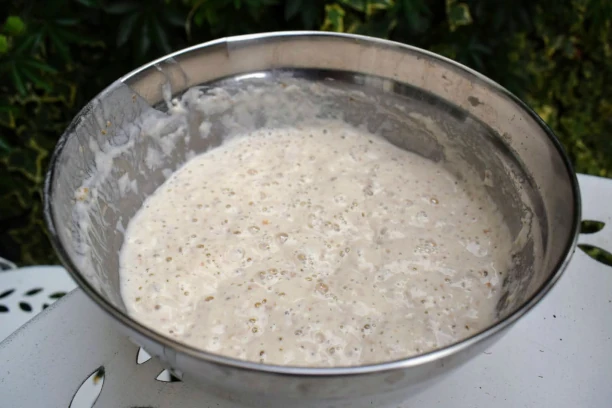Sourdough Starter

A properly maintained sourdough starter is the gateway to a multiverse of tasty homemade baked goods. Breads, rolls, buns, pretzels, pizza doughs – all of this and more is at your fingertips thanks to the yeasty froth of a healthy sourdough starter. But like Granny always said, look before you leap. Beginning a sourdough starter is a big responsibility that should not be undertaken lightly.
A sourdough recipe isn't quite as simple as a mere list of ingredients. Rather, it's an ongoing process that requires care and attention. It really takes a commitment to maintain a sourdough starter, much like adopting a pet. Your sourdough starter needs to be fed and watered regularly, groomed and trimmed, and kept at a comfortable temperature - but the most important ingredient is love.
Once your starter is established, Granny's Country Crust Sourdough Bread is a great place to get started.

Ingredients
Whole wheat flour All-purpose unbleached white flour Warm water
Method
- Day 1
Combine the flour and water in a non-reactive container such as one of glass, stainless steel, or food-grade plastic. The starter will eventually expand in size so be sure to use a voluminous vessel. Incorporate the ingredients well, then cover loosely with a wet kitchen towel or plastic wrap. Let your proto-starter sit in a warm room for 24 hours. - Day 2
You will not likely see any activity after the first day, although a bit of bubbling is possible. Discard half of the starter and then add 1 cup unbleached white flour and ½ cup warm water to the remainder. Mix well, cover with a clean towel, and let rest in a warm spot for 24 hours. - Day 3
On the third day it is time to begin two daily feedings, one in the morning and one in the evening. At this point you will likely notice some bubbling action in your starter and a sweet fruity aroma. Feed in the same manner as the previous day: dump out half of the starter, add 1 cup unbleached white flour and ½ cup warm water. - Day 4
About 12 hours after the last feeding, weigh out about half of the starter (113 grams) and discard the remainder. Add 1 cup unbleached white flour and ½ cup warm water to the remainder and mix well. Repeat the feeding a second time later in the day. - Day 5
Repeat the steps from day 4. Your starter should have doubled in volume by the end of day 5 and you can see many bubbles. If your starter doesn't look very active, continue feeding twice daily for a few more days. It can take more than one week for a starter to come alive, particularly in a cool house. - Day 6
Give your sourdough starter a final feeding and then transfer to its permanent container. Always cover loosely so that gas can escape the container. Store in the refrigerator and feed the starter once a week.

A sourdough starter is what causes bread to rise. It's been used by humans for thousands of years to give shape to leavened baked goods. While modern baking techniques typically give dough its rise using dry yeast, a 20th century invention, the time-honored tradition of sourdough imparts an unparalleled richness of flavor.
During the initial days of the sourdough process, your starter attracts natural yeasts and lactic acid bacteria from the air in the room. These microscopic organisms form a complex colony in your starter bowl, fermenting the dough by feeding on the flour and water that you feed them. The process is an ancient form of animal husbandry practiced on the smallest of scales.
Because a foamy tub of starter doesn't provide much in the way of human affection, we don't typically consider it to be a house pet, a farm animal, or even something that is alive at all. Livestock farming produces physical byproducts of an animal's body – meat or milk, furs or hides. But an animal doesn't have to be big and mammalian to be useful to humans. Consider the tiny silkworm for example. And it's the tiniest creatures of them all, Lactobacillus and its ilk, that work together through the magic of fermentation to create a sourdough starter.
And that magic, of course, is farts. More precisely, the waste gasses produced after the colony's feeding frenzy bubble up through the starter to leaven the dough. It's these yeast farts that gives sourdough bread it's light, airy texture and that distinctive tang. Fermentation is a hands-on example of how animal off-gassing contributes to physical changes in our environment. Once you understand the science of sourdough, the problem of flatulent cows seems less funny.